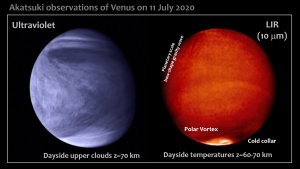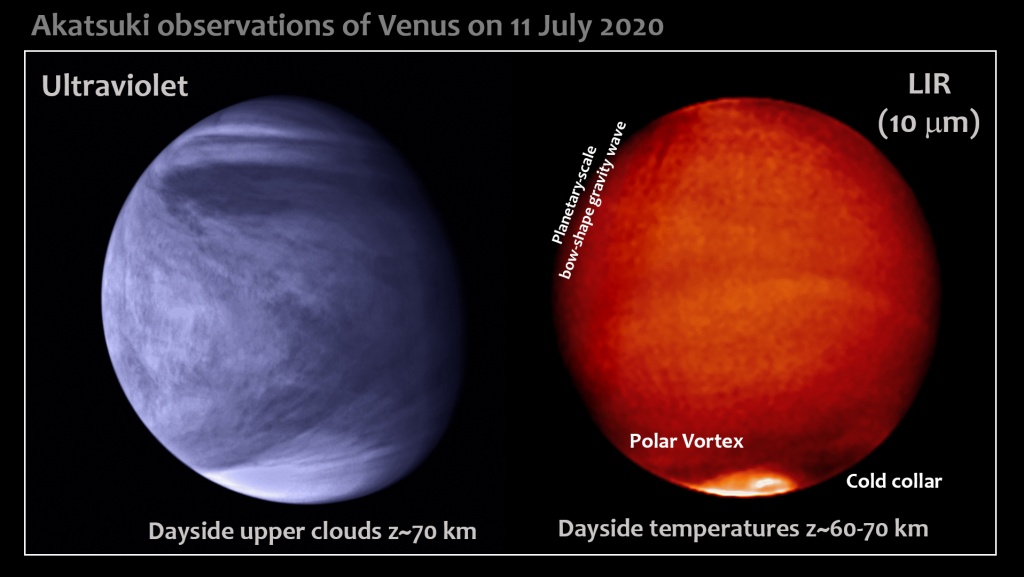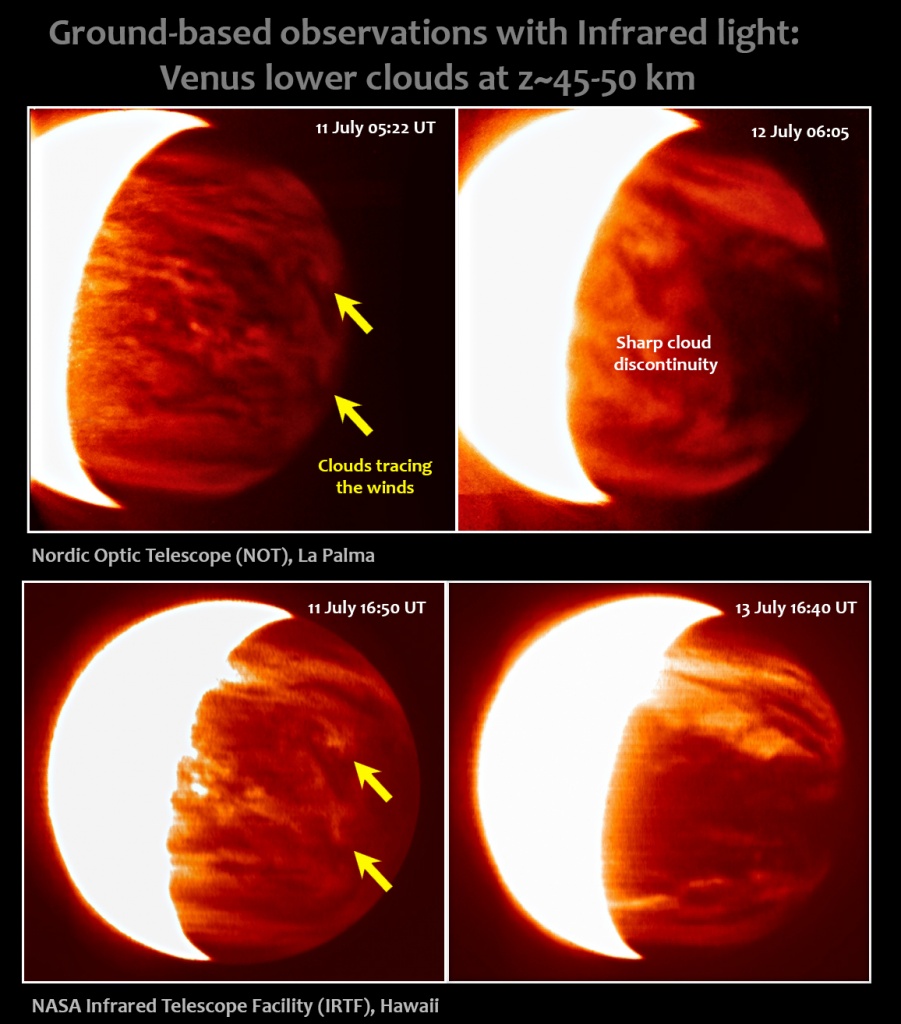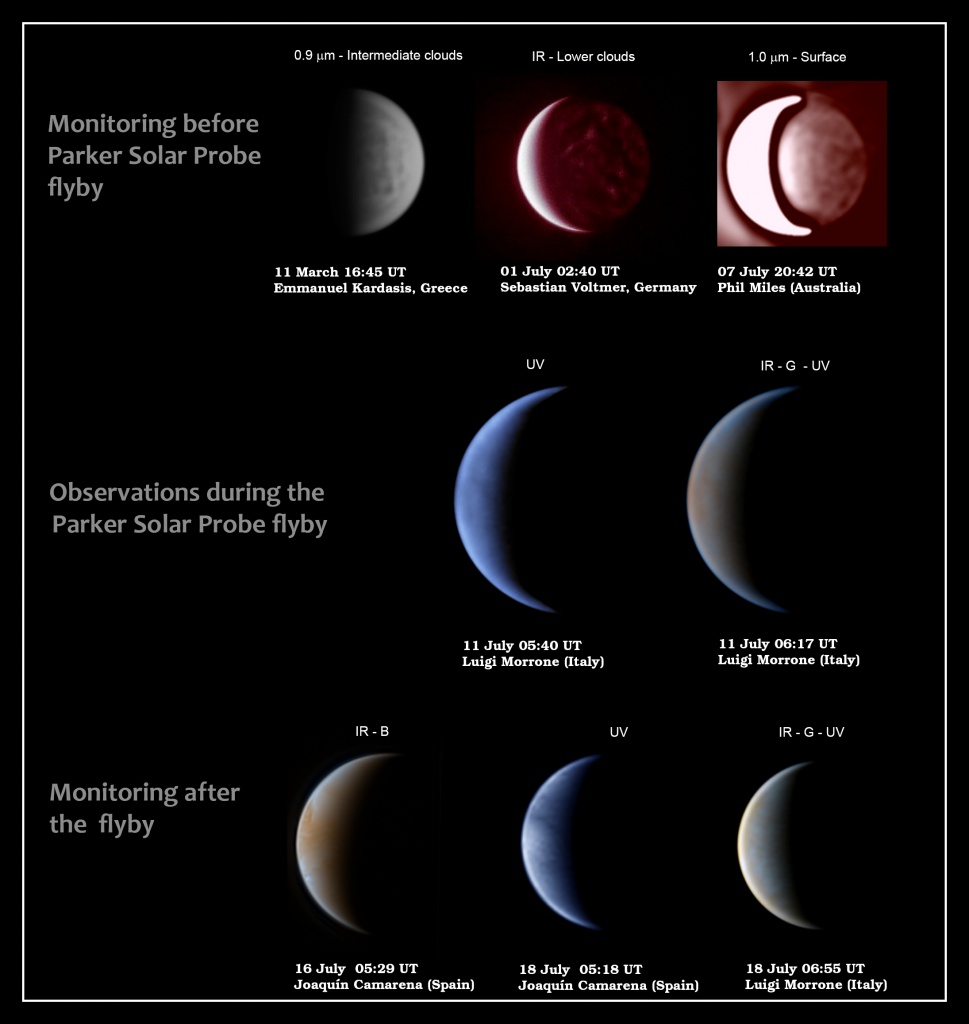EPSC2020: Parker Solar Probe, Akatsuki and Earth-bound observers give rare top-to surface glimpse of Venus

Observations of Venus by NASA’s Parker Solar Probe, JAXA’s Akatsuki mission and astronomers around the world have given a rare cloud-top-to-surface glimpse of the Earth’s neighbouring planet. The results are being presented this week at the Europlanet Science Congress (EPSC) 2020, which is taking place as a virtual meeting from 21 September – 9 October.
On 11 July 2020, the Parker Solar Probe, which is travelling to the inner Solar System to catch particles of the outer atmosphere of the Sun, completed the third of a series of flybys of Venus. From 19 June to 18 July, astronomers and members of the Akatsuki science team joined forces to support the probe’s encounter through a coordinated campaign of observations. The ground-based observations were contributed largely by amateur astronomers.
A similar campaign will be carried out to support the flyby of Venus by ESA’s BepiColombo mission on 15 October 2020.
“The campaign has resulted in multiple, multi-level observations right from the surface to the cloud-tops and airglow phenomena, which have given us unique insights into Venus’s atmosphere,” said Ricardo Hueso, a former member of ESA’s Venus Express mission and coordinator of the amateur participation. “The opportunity to observe Venus with so many instruments and with such a large collaboration means that we can enhance the scientific value of these short visits by the Parker Solar Probe and BepiColombo to Venus.”
Venus is the brightest object we see in the night-sky aside from the Moon. Although it is the most similar planet in size to the Earth, it is a radically different world. Its thick atmosphere, composed mainly of the greenhouse gas, carbon dioxide, keeps the surface at temperatures of 460 degrees Celsius and pressures comparable to those found at the depths of Earth’s oceans. The upper atmosphere is home to multiple cloud layers, made of sulphuric acid with traces of water, which move at hurricane-like speeds. Despite this hostile environment, the recent discovery of phosphine molecules in Venus atmosphere has reactivated speculation about the possible presence of ‘aerial’ microbial life existing in the upper clouds of the planet. Spacecraft passing close to Venus as they travel through the inner Solar System can gather valuable data to help us understand the planet’s properties and its evolution.
During the campaign, the Parker Solar Probe observed the nightside of the planet from the surface to the upper atmosphere and Akatsuki obtained data of the upper clouds. Back on Earth, researchers used the Infrared Telescope Facility (IRTF) in Hawaii and the Nordic Optical Telescope (NOT) in La Palma to probe the deeper clouds of Venus on the night-side of the planet. Additional observations of the deeper clouds and Venus surface were obtained at Pic du Midi in France. Amateur astronomers observed the upper and middle clouds in ultraviolet, violet and near infrared wavelengths. Some amateur observers also managed to observe the Venus surface through the warm radiation escaping from the planet through Venus’s clouds.
The global ground-based support from professional telescopes was led by Javier Peralta, an astronomer who has coordinated similar campaigns in support of past missions. The amateur ground-based support campaign was coordinated through the Europlanet 2024 Research Infrastructure.
“It was a really exciting opportunity to have researchers using the IRTF and NOT join forces with amateur astronomers to observe Venus at the same time as Parker and Akatsuki,” said Dr Peralta. “These observations have also given us the chance to monitor the evolution of a fast-moving, giant, longitudinal divide in the deeper clouds of Venus that has been previously observed between January and April 2020 by amateur astronomers.”
Observations continued and intensified throughout August, when Venus was best observed from the Earth, and will culminate in October, when the BepiColombo mission will flyby Venus on its journey to Mercury.
“There are clear signs of changes over time in the clouds of Venus if we compare observations by the Venus Express mission in 2006-2014 with more recent observations by Akatsuki since 2015. The data obtained by amateur and professional observers in these campaigns associated with flybys this summer and autumn will extend our knowledge of Venus weather and its variability,” said Dr Peralta.
EPSC Presentations
Wednesday 23 September, 10:10-10:450 CEST: Interview session about BepiColombo flyby of Venus with guests, Johannes Benkhoff, Ricardo Hueso and Javier Peralta: https://meetingorganizer.copernicus.org/EPSC2020/session/38646
Amateur Ground-based Support of the first BepiColombo flyby of Venus, Itziar Garate-Lopez et al: https://meetingorganizer.copernicus.org/EPSC2020/EPSC2020-1060.html
Amateur observations of a planetary-scale wave in the middle clouds of Venus, Emmanouil Kardasis, Javier Peralta, Grigoris Maravelias, and Yaroslav Naryzhniy: https://meetingorganizer.copernicus.org/EPSC2020/EPSC2020-712.html
Modelling the in situ solar and thermal radiation environment for future entry probe missions to Venus, P. Irwin et al: https://meetingorganizer.copernicus.org/EPSC2020/EPSC2020-312.html
Links:
- Parker Solar Probe: https://www.nasa.gov/content/goddard/parker-solar-probe/
- BepiColombo mission: www.esa.int/bepicolombo
- Amateur ground-based support of Parker Solar Probe and BepiColombo: http://pvol2.ehu.es/bc/Venus/
- Simulation of a descent through Venus’s atmosphere to the surface by Oxford University’s Professor Patrick Irwin and Lightcurve Films: https://www.youtube.com/watch?v=YkeWhgwp7Xo&
Science Contacts:
Javier Peralta
Coordinator of Parker Solar Probe Amateur Ground-based Support
Algeciras
Spain
javier.peralta.calvillo@gmail.com
Ricardo Hueso
Física Aplicada I, Planetary Sciences Group, UPV/EHU
Bilbao, Spain
Tel: +34 94601 4262
ricardo.hueso@ehu.eus
Media contacts:
Anita Heward
EPSC 2020 Press Officer
+44 7756 034243
aheward@europlanet-society.org
epsc-press@europlanet-society.org
Livia Giacomini
EPSC2020 Press Officer
epsc-press@europlanet-society.org
Adriana Postiglione
EPSC2020 Press Officer
epsc-press@europlanet-society.org
Images:

Figure 1: Akatsuki observations of Venus at the time of the Parker Solar Probe flyby. These observations sampled the upper atmosphere at roughly 70 km altitude above the surface. Credit: JAXA, Planet-C

Figure 2: Observations of Venus lower clouds in the night-side of the planet. Images from NOT acquired by J. Peralta (JAXA) and R. Baena (IAC). Images from IRTF acquired by E. Young (SwRI). These observations sampled the middle atmosphere at roughly 45-50 km altitude above the surface. Credit: NOT/ NASA, IRTF

Figure 3: Selection of amateur observations of Venus before, during and after the Parker Solar Probe flyby. These observations sampled Venus atmosphere from the surface to the upper clouds. These and many other amateur images are available at the PVOL database http://pvol2.ehu.eus. Credit: Emmanuel Kardasis/Sebastian Voltmer/Phil Miles/Joaquin Camarena/Luigi Morrone
Further information:
About the Europlanet Science Congress (EPSC) 2020
EPSC (https://www.epsc2020.eu/) will take place as a virtual meeting for the first time in 2020 from 21 September to 9 October. The meeting has a hybrid format of asynchronous presentations and discussion alongside a programme of live webinars.
The Europlanet Science Congress (formerly the European Planetary Science Congress) is the annual meeting place of the Europlanet Society. With a track record of 14 years and regularly attracting around 1000 participants, the Europlanet Science Congress is the largest planetary science meeting in Europe. It covers the entire range of planetary sciences with an extensive mix of talks, workshops and poster sessions while providing a unique space for networking and exchange of experiences.
Follow on Twitter via @europlanetmedia and using the hashtag #EPSC2020
About Europlanet
Since 2005, Europlanet (www.europlanet-society.org) has provided Europe’s planetary science community with a platform to exchange ideas and personnel, share research tools, data and facilities, define key science goals for the future, and engage stakeholders, policy makers and European citizens with planetary science.
The Europlanet 2024 Research Infrastructure (RI) has received funding from the European Union’s Horizon 2020 research and innovation programme under grant agreement No 871149 to provide access to state-of-the-art research facilities and a mechanism to coordinate Europe’s planetary science community.
The Europlanet Society promotes the advancement of European planetary science and related fields for the benefit of the community and is open to individual and organisational members. The Europlanet Society is the parent organisation of the European Planetary Science Congress (EPSC).

